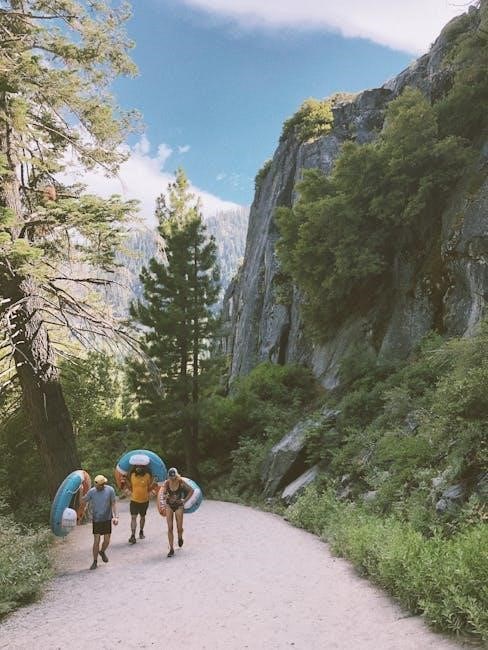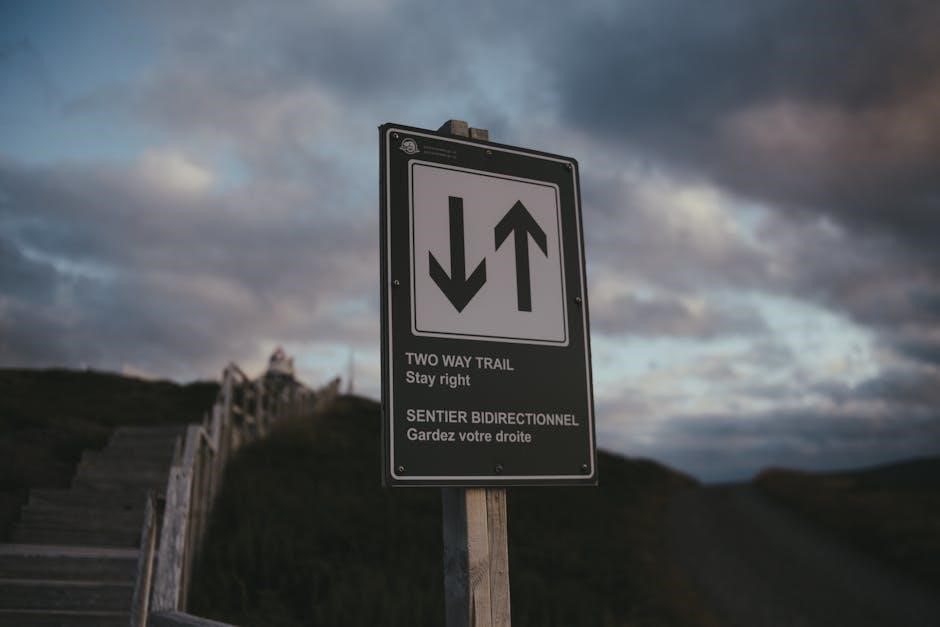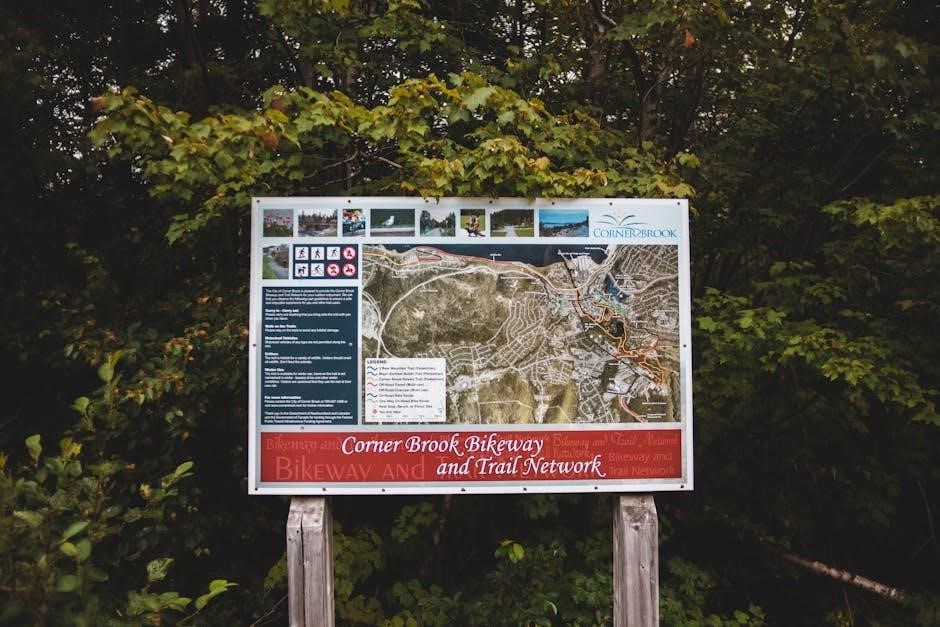The Appalachian Trail is a 2‚190-mile iconic footpath from Georgia to Maine‚ offering diverse landscapes and immersive wilderness experiences. Guided hikes provide expert navigation‚ safety‚ and logistical support‚ making the journey accessible and enriching for hikers of all levels‚ while fostering camaraderie and a deeper connection to nature.
1.1 Overview of the Appalachian Trail
The Appalachian Trail (AT) is a 2‚190-mile premier long-distance hiking destination‚ stretching from Georgia to Maine. It traverses 14 states‚ offering diverse landscapes‚ from lush forests to rugged mountains and scenic valleys. Established in 1937‚ the AT is a iconic adventure destination‚ attracting thousands of hikers annually. Whether section hiking or thru-hiking‚ the AT promises unforgettable experiences‚ showcasing Americas natural beauty and rich outdoor heritage. With its well-marked trails and historic significance‚ the AT provides a unique opportunity to explore vast wilderness areas‚ cultural landmarks‚ and breathtaking vistas‚ making it a must-visit destination for outdoor enthusiasts and nature lovers alike.
1.2 History and Significance
The Appalachian Trail (AT) was established in 1937‚ becoming a iconic symbol of adventure and resilience. It stretches 2‚190 miles‚ showcasing America’s natural beauty and cultural heritage. The trail features historic landmarks like the Blood Mountain Shelter‚ built by the Civilian Conservation Corps in 1934. Guided hikes highlight the AT’s significance‚ offering insights into its history‚ wildlife‚ and conservation efforts. These tours preserve the trail’s legacy while fostering a deeper connection to nature and local communities‚ making the AT a timeless destination for outdoor enthusiasts and history buffs alike‚ ensuring its enduring appeal for generations to explore and cherish.
1.3 Why Choose Guided Hikes?
Guided Appalachian Trail hikes offer a structured and enriching experience‚ providing expert navigation‚ safety‚ and logistical support. With knowledgeable guides‚ hikers gain insights into the trail’s history‚ wildlife‚ and hidden gems‚ enhancing their connection to nature. These tours cater to all skill levels‚ ensuring a tailored adventure. Meals‚ accommodations‚ and gear are often managed‚ allowing hikers to focus on the journey. Guided hikes foster camaraderie and shared experiences‚ creating unforgettable memories. They are ideal for those seeking a stress-free‚ organized‚ and immersive exploration of one of the world’s most iconic trails‚ combining adventure with education and community.

Benefits of Guided Appalachian Trail Hikes
Guided hikes offer expert knowledge‚ safety‚ and logistical support‚ enhancing the Appalachian Trail experience. They provide immersive learning‚ foster camaraderie‚ and ensure a memorable adventure.
2.1 Expert Knowledge and Safety
Guided Appalachian Trail hikes prioritize safety and expertise‚ ensuring a secure and informed journey. Experienced guides possess deep knowledge of the terrain‚ reducing navigation risks and enhancing overall safety. They are trained in Wilderness First Aid and emergency response‚ providing reassurance for hikers. Guides also share insights into local wildlife‚ history‚ and ecosystems‚ enriching the hiking experience; Their familiarity with trail conditions and weather patterns allows for better decision-making‚ ensuring a smoother and more enjoyable adventure. With expert guidance‚ hikers can focus on soaking in the natural beauty while staying safe and informed throughout their journey.

2.2 Logistical Support and Convenience
Guided Appalachian Trail hikes offer comprehensive logistical support‚ simplifying the hiking experience. Guides handle meal planning‚ gear transportation‚ and accommodation arrangements‚ allowing hikers to focus on their adventure. They manage permits‚ trailhead shuttles‚ and itinerary coordination‚ eliminating the stress of planning. This support is particularly valuable for those unfamiliar with long-distance hiking‚ ensuring a seamless journey. With logistical details covered‚ hikers can fully immerse themselves in the natural beauty and camaraderie of the trail‚ creating a more enjoyable and stress-free experience from start to finish.
2.3 Enhanced Learning and Camaraderie
Guided Appalachian Trail hikes enrich the experience through expert insights into trail history‚ wildlife‚ and navigation‚ fostering a deeper connection to the environment. These tours create opportunities for camaraderie‚ as hikers share adventures and challenges‚ forming lasting bonds. Guides often share stories and knowledge‚ enhancing learning and appreciation for the trail’s cultural and natural significance. The structured‚ supportive atmosphere encourages collaboration and mutual encouragement‚ making the journey more rewarding and memorable. This blend of education and community transforms a solo hike into a shared adventure‚ enriching both the individual and collective experience on one of the world’s most iconic trails.

Planning and Preparation for Your Hike
Planning and preparation are crucial for a successful Appalachian Trail hike. Guidebooks‚ maps‚ and logistical support ensure readiness‚ while physical and mental conditioning enhance resilience for the adventure.
3.1 Best Time to Hike the Appalachian Trail
The best time to hike the Appalachian Trail is from spring to fall‚ with most thru-hikers starting in April. Spring offers mild weather and blooming wildflowers‚ while summer provides warm temperatures but busier trails. Fall brings cooler conditions and stunning foliage‚ making September and October popular for section hikes. Winter hiking is possible but challenging due to cold and snow. Planning your hike according to your weather preferences and crowd tolerance is key. Guidebooks and expert guides can help optimize your timing for an enjoyable and safe experience on this iconic trail.
3.2 Essential Gear and Equipment
For a successful Appalachian Trail hike‚ essential gear includes durable hiking boots‚ a lightweight tent‚ sleeping bag‚ and backpack. Navigation tools like a GPS or guidebook are crucial‚ along with a water filtration system and first-aid kit. Layered clothing for varying weather conditions is a must. Ultralight options are popular for long-distance hikers to reduce weight. Guided tours often provide or manage these necessities‚ allowing hikers to focus on the journey. Proper equipment ensures comfort‚ safety‚ and readiness for the trail’s challenges‚ making the adventure more enjoyable and stress-free.
3.3 Physical and Mental Conditioning
Physical conditioning for the Appalachian Trail involves building endurance and strength through regular cardio and muscle-strengthening exercises. Gradually increase hiking distances to adapt to the trail’s demands. Mentally‚ cultivate resilience and focus to handle long days and unpredictable conditions. Practice mindfulness or meditation to stay motivated. Building mental toughness and a positive mindset is crucial for overcoming challenges. Proper preparation ensures a safer and more enjoyable experience‚ allowing hikers to embrace the trail’s beauty and rewards confidently. Guided hikes often provide structured workouts and mental strategies to help participants prepare effectively.

Navigating the Appalachian Trail
Navigating the Appalachian Trail requires guidebooks‚ maps‚ and GPS. Expert guides use these tools to ensure hikers stay on track‚ while trail markers like white and blue blazes provide clear direction‚ enhancing safety and confidence during the journey.
4.1 Guidebooks and Maps
Guidebooks and maps are indispensable tools for navigating the Appalachian Trail. Official resources like the Appalachian Trail Guidebook provide detailed trail descriptions‚ mileages‚ and waypoints‚ while maps from the National Park Service and Appalachian Trail Conservancy offer comprehensive overviews. These resources highlight routes‚ elevations‚ and key landmarks‚ helping hikers and guides plan itineraries and stay on track. Many hikers also use GPS devices and apps to supplement traditional maps‚ enhancing navigation accuracy. Guides often rely on these tools to ensure a smooth and informed journey‚ making them vital for a successful and enjoyable experience along the trail.
4.2 Understanding Trail Markers
Understanding trail markers is crucial for navigating the Appalachian Trail. The trail is marked with standard white blazes‚ indicating the main route‚ while blue blazes denote side trails to shelters or water sources. Signs at intersections provide directions and distances to key points. Guides often teach hikers to recognize these markers‚ ensuring navigation stays straightforward. Familiarity with trail signs enhances safety and confidence‚ allowing hikers to focus on enjoying the journey. Recognizing these markers is essential for staying on track and avoiding unnecessary detours‚ making it a key skill for a successful and stress-free hiking experience.
4.3 Role of Expert Guides in Navigation
Expert guides play a vital role in navigating the Appalachian Trail‚ ensuring hikers stay on track and safe. They use detailed guidebooks‚ maps‚ and GPS to plan routes and anticipate challenges. Guides are familiar with trail markers‚ such as white and blue blazes‚ and teach hikers to recognize them. Their local knowledge helps avoid detours and manage unexpected terrain. Guides also use satellite imagery to prepare for difficult sections‚ ensuring a smoother journey. By handling navigation‚ guides allow hikers to focus on enjoying the scenery and experience‚ making the adventure more accessible and stress-free for all skill levels.

Challenges on the Appalachian Trail
Hikers face physical demands‚ mental fatigue‚ and unpredictable weather. Navigating rugged terrain‚ managing gear‚ and encountering wildlife add complexity to the journey‚ testing endurance and resilience.
5.1 Physical Demands of Long-Distance Hiking
Long-distance hiking on the Appalachian Trail requires immense physical endurance. Hikers carry heavy backpacks‚ often hiking 20-25 miles daily‚ across varying terrain from flat paths to steep climbs. Weather conditions like rain‚ snow‚ and heat add to the challenge. Fatigue‚ blisters‚ and muscle soreness are common. Proper conditioning and pacing are crucial to avoid injuries and maintain energy levels. The physical demands are significant‚ but many find the rewards well worth the effort‚ as the trail tests stamina and resilience in a way that pushes hikers to their limits while offering unparalleled outdoor experiences.
5.2 Mental and Emotional Challenges
Long-distance hiking on the Appalachian Trail presents significant mental and emotional challenges. Isolation‚ fatigue‚ and unpredictable weather can test a hiker’s resolve. Homesickness and self-doubt often arise‚ especially during solo moments. Staying motivated requires resilience and focus. Trail magic and camaraderie with fellow hikers can uplift spirits. Managing expectations and embracing the journey helps navigate emotional highs and lows. Mental fortitude is as crucial as physical strength in completing the hike successfully. Overcoming these challenges fosters personal growth and a profound sense of accomplishment‚ making the experience deeply rewarding for those who persevere.

Choosing the Right Guide Service
Choosing the right guide service is crucial for a safe and enriching Appalachian Trail experience. Reputable services offer expert knowledge‚ logistical support‚ and tailored adventures‚ ensuring a memorable journey.
6.1 What to Look for in a Guide Service
When selecting a guide service for the Appalachian Trail‚ prioritize experience‚ certifications‚ and local knowledge. Ensure guides have Wilderness First Aid training and extensive trail familiarity. Check for positive reviews and testimonials‚ focusing on expertise‚ safety protocols‚ and group dynamics. A reputable service will offer clear communication‚ detailed itineraries‚ and a commitment to environmental stewardship. Consider smaller group sizes for personalized attention and a more immersive experience. Verify certifications and ask about their approach to navigation and logistical support. A trustworthy guide service will enhance your safety and overall hiking experience‚ ensuring a memorable and enriching journey on the Appalachian Trail.
6.2 Importance of Reviews and Testimonials
Reviews and testimonials are crucial for evaluating a guide service’s reliability and quality. They provide insights into a service’s strengths‚ such as guide expertise‚ safety measures‚ and group dynamics. Look for feedback on websites‚ forums‚ and social media‚ focusing on hikers’ experiences with navigation‚ logistical support‚ and overall satisfaction. Positive reviews often highlight knowledgeable guides‚ well-organized itineraries‚ and a commitment to safety. Be cautious of red flags like poor communication or safety concerns. Asking for direct references can also help verify a service’s credibility. Prioritizing reviews ensures you choose a trustworthy guide service‚ enhancing your safety and enjoyment on the Appalachian Trail.

Budgeting for Your Guided Hike
Guided Appalachian Trail hikes cost $100-$300 per person daily‚ covering meals‚ gear‚ and accommodations. Budgeting early and comparing packages helps manage expenses effectively for a stress-free adventure.
7.1 Cost Factors and Inclusions
Guided Appalachian Trail hikes typically cost $100-$300 per person daily‚ covering meals‚ accommodations‚ and gear. Prices vary based on hike duration‚ guide expertise‚ and luxury level. Inclusions often feature expert navigation‚ logistical support‚ and immersive experiences. Longer hikes or premium services increase costs‚ while group tours and off-peak seasons may offer discounts. Budgeting early ensures a smooth adventure‚ with clear inclusions like meals and gear provided‚ allowing hikers to focus on the journey. Transparent pricing helps allocate funds effectively‚ making the experience both enjoyable and stress-free.
7.2 Tips for Reducing Expenses
To minimize costs on a guided Appalachian Trail hike‚ consider joining group tours‚ which reduce per-person expenses. Opt for off-peak seasons when prices are lower and choose shorter itineraries. Pack lightweight gear to avoid extra fees and bring reusable items like water bottles. Research companies offering discounts for early bookings or student rates. Budgeting early and comparing packages can also help allocate funds effectively. These strategies allow hikers to enjoy a high-quality experience while keeping costs manageable‚ ensuring a memorable adventure without financial strain.

Safety on the Appalachian Trail
Carry a first-aid kit‚ emergency shelter‚ and GPS. Stay informed about weather and trail conditions. Hike with a buddy and keep emergency contacts accessible for added security.
8.1 Common Risks and Hazards
Hikers on the Appalachian Trail face various risks‚ including unpredictable weather‚ steep terrain‚ and wildlife encounters. Inclement weather like rain or snow can make trails slippery‚ increasing the chance of falls; Physical exhaustion and injuries‚ such as sprains or blisters‚ are common due to the trail’s demanding nature. Additionally‚ hikers may encounter wildlife like bears or snakes‚ requiring proper precautions. Navigation errors and gear failures can also pose challenges. Staying informed about trail conditions and carrying essential safety items‚ like a first-aid kit and GPS‚ are crucial for mitigating these risks. Guides often provide expertise to navigate these hazards effectively.
8.2 Safety Measures and Emergency Preparedness
Ensuring safety on the Appalachian Trail requires careful preparation and awareness. Hikers should carry a first-aid kit‚ emergency shelter‚ and a GPS device. Staying informed about weather conditions and trail updates is crucial. Guides often provide contingency plans and safety protocols‚ while hikers should always carry a map and know how to use it. Hiking with a buddy and sharing your itinerary with someone outside the group enhances safety. Proper emergency preparedness‚ including knowing how to treat injuries and navigate‚ is essential for handling unexpected situations. Guides play a key role in managing risks and ensuring a secure hiking experience.

Cultural and Historical Experiences
The Appalachian Trail offers rich cultural and historical experiences‚ with landmarks like the Roan High Knob Shelter and Blood Mountain’s stone shelter. Hikers engage with local communities‚ enjoying trail magic and stories that highlight the region’s heritage and outdoor legacy.
9.1 Historical Landmarks and Cultural Significance
The Appalachian Trail is dotted with historical landmarks‚ such as the Roan High Knob Shelter‚ the highest elevation shelter‚ and Blood Mountain’s stone shelter‚ built in 1934 by the CCC. These sites reflect the region’s rich history and conservation efforts. Guided hikes offer insights into these landmarks‚ connecting hikers to the trail’s heritage. The trail also passes through areas with deep cultural significance‚ allowing hikers to engage with local communities and experience the region’s unique traditions and stories‚ enriching the hiking experience with a sense of history and cultural connection.
9.2 Engaging with Local Communities
Guided Appalachian Trail hikes often include opportunities to engage with local communities‚ fostering cultural connections and enriching the hiking experience. Many trails pass through charming towns and villages‚ where hikers can explore local traditions‚ cuisine‚ and history. Guides frequently share stories about the region’s heritage‚ introducing hikers to hidden gems like family-owned diners or artisan shops. Some tours include visits to historical sites‚ such as the Roan High Knob Shelter‚ offering insights into the area’s conservation efforts. These interactions create a deeper appreciation for the trail’s cultural significance and the people who call the Appalachian region home.



